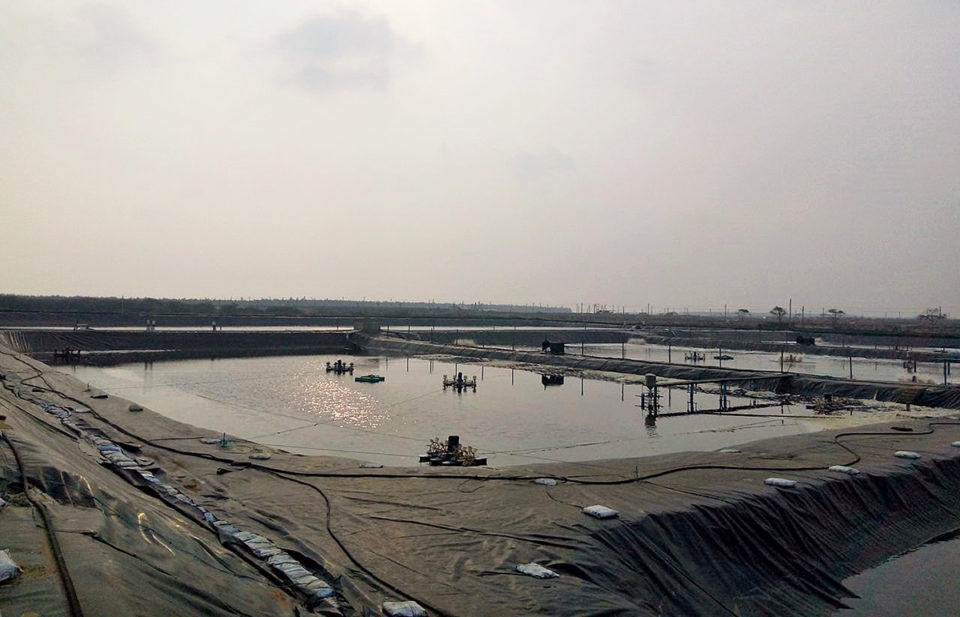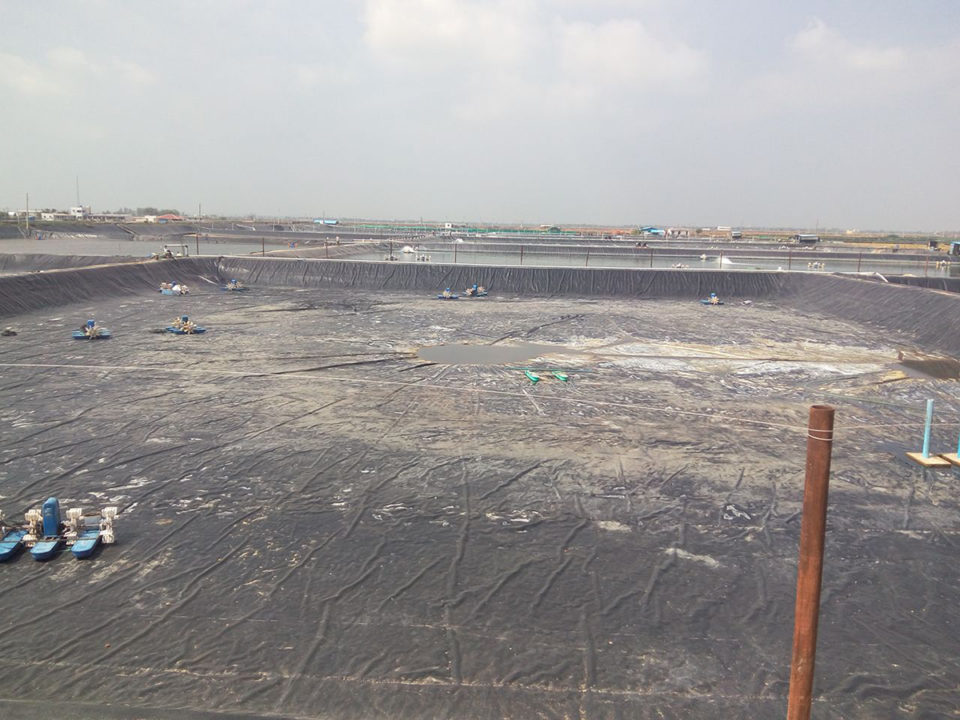Results include improved production efficiency through increased annual cycles, aeration rates and stocking densities

Shrimp culture is generally practiced in coastal areas due to the availability of brackish or seawater for supplying ponds. In addition, some of the land is swampy or sandy, and sometimes organic soils may occur. Such land is not suitable for crops or plantations, and therefore, the price is relatively cheap.
Ponds constructed in soils containing iron pyrite (potential acid-sulfate or active acid-sulfate soils) will develop a low pH, which causes a problem for shrimp culture. Ponds built in sandy soil do not hold water very well. Organic soils do not allow stable embankments and have an elevated oxygen demand. Because of the low-lying land, shrimp ponds constructed in these areas face difficulties in drainage and drying after harvest. Pond bottoms do not completely dry out, and after culturing shrimp for a few crops, the pond bottom becomes deteriorated and this can stress shrimp and favor disease outbreaks.
Among several management schemes that can be used is the practice of separating the pond water and the soil by the use of plastic pond liners, which typically have achieved the best, cost-effective results in shrimp aquaculture. Plastic materials have been used for a long time in reservoirs, dams and ponds for agricultural purposes. But it is only in the last few years that this technology has been widely applied to aquaculture.
Plastic materials suitable for lining shrimp ponds are HDPE (high density polyethylene) and poly vinyl chloride (PVC). As both HDPE and PVC incorporate anti-ultraviolet substances, these two materials can resist deterioration by UV light, which allows them to last for many years. These materials are flexible and come in rolls of sheeting that can be easily fused or glued together during installation. The recommended thickness for a shrimp pond liner is at least 0.75 mm, and many suppliers of HDPE and PVC liners guarantee their product use under normal conditions for five to 10 years.

Advantages
The use of plastics to line pond aquaculture bottoms and embankments prevents contact with acid-sulfate soils to avoid low pH in pond bottoms and water, which normally would create problems in shrimp ponds, especially during the rainy seasons.
Pond water quality is more easily managed because there are no negative effects on pond water quality from contact with bottom and dike soils. Liners effectively prevent soil-water interaction and prevent the issue of soil acidity, stop salinization of neighboring areas, and control seepage of water into the ponds in areas with a high water table.
Liners shorten pond cleaning and preparation time, requiring only four to eight days to complete the process compared with 30 to 45 days for the normal earthen pond cleaning and extensive drying process. Therefore, the number of crops per year can be increased to make annual pond productivity higher. In addition, harvesting can be more effective during the rainy season because plastic-lined pond can still be cleaned. And no tractor earth work is required after the liners have been installed.
During the culture period, suspended solids and other waste can easily be removed by gravity flow through drains (typically in the center of the pond), so that less organic matter will accumulate in the ponds.
Liners prevent the erosion of dikes and levees from waves, wind, and aerator-generated water currents, which reduces pond maintenance and repair expenses. And lined ponds can generally be aerated more intensively, supporting higher stocking densities and yields per unit area.
Because the pond bottom is cleaner, at harvest time there are fewer shrimp with dirty gills (accumulated organic sludge), and cleaner shrimp will command better prices.
Disadvantages
Foremost, the initial investment costs to line ponds are high – $10,000 to $100,000 or more – depending on the type of liner and size of pond and other factors. Significant manual labor and/or equipment is required for proper pond cleaning and preparation before the next production cycle can proceed. The use of heavy equipment to clean the pond after harvest is limited due to the risk of damaging the liner.
It can be more difficult to initiate a plankton bloom in lined ponds before stocking of shrimp postlarvae. And as the culture period progresses, phosphorus accumulates in pond waters and phytoplankton blooms tend to increase. This can cause low night time dissolved oxygen levels and plankton die-offs, which can also cause dissolved oxygen deficiencies.
And because of the frequent incidence of increased blooms of phytoplankton and associated problems with dissolved oxygen depletion, more mechanical aeration may be required in lined ponds than in those ponds without liner, especially during the second half of the culture period.
Requirements before installation
For a pond to be properly lined, it must be well prepared so that the soil is smooth and compacted, with sharp or extraneous materials like rocks or tree stumps and branches removed across the surface of the pond bottom, and extending up along all the internal slopes of the embankments. If using a central drain, which is very strongly recommended, it must be properly designed and installed.
The plastic sheets should be lined along the smooth surface of the pond bottom and dike, and must be fixed on the top of the dike by burying the edges in the dike in a 50 cm trench. For ponds with bottoms below the outside water level or ponds built where the water table is near the soil surface, some ventilation pipes may be needed to allow water from under the plastic sheet to escape and prevent bubbles to form and the plastic liner from inflating.
If possible – as in the case of new ponds to be built – pond shape should be designed to minimize the number of plastic liner sheets that need to be connected (fused or glued together), as joint areas are the weakest part of plastic liners. The plastic sheets should have enough overlap between them (about 5-6 inches for each joint) so they can be properly fused or glued together. Special attention should be given to the central drainage and water gate areas, because the plastic liner can contact other types of materials and result in weaker joints.
Perspectives
Properly installed and managed plastic-lined ponds can significantly improve the production efficiency of shrimp culture ponds, allowing for more production cycles (turnovers) per year because of reduced down time between cycles, and higher mechanical aeration rates and stocking densities. The capital cost of lining ponds can be very significant, so a thorough feasibility analysis is recommended when considering this production tool.
For additional information, interested readers can check Asian Shrimp News, 2nd Quarter, 1994, Published by Asian Shrimp Culture Council, Issue No. 18. And Boyd, C.E., Tucker, C.S., (2014). Lined Ponds. In Handbook for Aquaculture Water Quality, Craftmaster Printers, Auburn, Alabama, USA, pp333-339.
Authors
-

-

Claude E. Boyd, Ph.D.
Professor Emeritus
School of Fisheries, Aquaculture and Aquatic Sciences
Auburn University
Auburn, Alabama 36849 USA
Tagged With
Related Posts

Health & Welfare
Acclimating shrimp postlarvae before pond stocking
Shrimp postlarvae acclimation before stocking into the various growout systems (ponds, raceways, tanks) is a critical – and often overlooked, sometimes taken for granted – step in the shrimp culture process. Various water quality parameters should be changed slowly so that the young shrimp have the time to gradually adapt to the new conditions.

Health & Welfare
Building a better shrimp nursery, part 1
Shrimp nursery systems offer an important opportunity to increase profits. Properly designed and operated nurseries are highly biosecure facilities to grow postlarvae at very high densities.

Responsibility
They’re ‘everywhere’: The pervasiveness of microplastics
How has the plastic in aquaculture operations contributed to microplastic pollution? And is plastic pollution contaminating aquaculture products? The Advocate takes a closer look.

Responsibility
A look at various intensive shrimp farming systems in Asia
The impact of diseases led some Asian shrimp farming countries to develop biofloc and recirculation aquaculture system (RAS) production technologies. Treating incoming water for culture operations and wastewater treatment are biosecurity measures for disease prevention and control.

